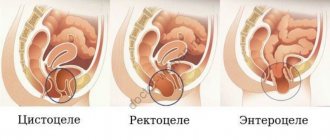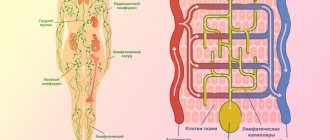In this section you will learn:
- How often does it occur?
- Causes of miscarriage
- Symptoms
- Stages
- Possible complications
- How to diagnose
- How to treat
- Recovery after treatment
- Prevention
An unexpected termination of pregnancy in the first trimester, accompanied by pain and bleeding, is called spontaneous abortion, or miscarriage. This dangerous condition not only stops the development of the embryo, but also threatens the life of the woman. The consequences of a miscarriage damage the reproductive organs and reduce the chances of becoming pregnant in the future.
What are the signs of a miscarriage?
To understand what's going on, you need to understand what spontaneous miscarriage looks like. The most common symptom is excessive bloody discharge with clots. Sometimes they can be weak at first, and then quite large. You should monitor your condition and if even slight bleeding begins, you should immediately consult a doctor.
Sometimes a miscarriage can start suddenly. But it happens that before this there may be slight nagging pain in the lower abdomen, lower back, and brown spotting.
Women may not immediately realize that they are having a miscarriage. Especially if the delay is only a few days, and the test was not done, then you might think that your period just started.
But usually, a woman who already knows about her pregnancy remembers how a spontaneous miscarriage occurs forever. In most cases, this is heavy bleeding with blood clots, mucus and severe abdominal pain. If measures are not taken immediately, chills, fever, and the skin may become pale. The patient may even lose consciousness. If a woman does not immediately see a doctor or call an ambulance, she may even die from blood loss, since sometimes such bleeding can be incredibly serious.
Spontaneous miscarriage may also have symptoms such as nausea, vomiting, frequent urination, dizziness, weakness,
What can cause early miscarriage?
Why does it happen that a miscarriage occurs? Many reasons can be given here, but in each specific case, research is carried out, the patient undergoes tests.
The causes of spontaneous abortion may be as follows in the first trimester:
- Increased contractile activity of the uterus, which literally “pushes out” the embryo.
- Genetic abnormalities in the fetus. Sometimes this happens once in one woman, as a result of genetic “breakdowns”. And it happens that it’s all about the genes of the future father and mother, and therefore it is necessary to look for problems together with a geneticist.
- Lack of the hormone progesterone. This is the so-called “pregnancy hormone”. If it is not enough, then it is prescribed additionally.
- Immunological disorders that prevent the embryo from developing normally.
- Intoxication.
- In the second trimester, the reasons for miscarriage may be slightly different:
- Uterine fibroids.
- Adhesive processes in the pelvic organs.
- Polyps in the uterus that prevent the embryo from developing normally.
- Endometriosis, which causes connective tissue to grow outside the uterus.
- Pathology of the cervix, namely an open cervix, which does not allow you to carry a child to term and give birth to it on time.
- Infections that can cross the placenta and cause fetal death.
- Some chronic diseases of the mother.
But besides this, there may be many other specific reasons that are individual for each woman. For example, hard physical work, work in hazardous enterprises, severe stress and anxiety can also cause spontaneous abortion. Many women are at risk of spontaneous miscarriage, but not everyone can have an abortion. Much depends on the state of health, immunity, even emotional state.
Main causes
What is increased uterine tone and why does it occur? Today, there are 9 main reasons that provoke hyperexcitability of smooth muscles.
- Hormonal background. An insufficient amount of the hormone progesterone, as well as an excess of prolactin, is the main cause of hypertension.
- Pathology in the field of gynecology:
- underdevelopment (infancy). It is a congenital underdevelopment of the reproductive system, accompanied by a small size of the uterus and other reproductive organs;
- endometriosis as a cause of uneven contraction;
- fibroids localized in the myometrial layer. negatively affects fetal growth.
- Early toxicosis and late gestosis, accompanied by complications. This factor causes electrolyte imbalance.
- Rhesus conflict between mother and fetus. When a woman is Rh negative and a man is Rh positive, there is a high percentage that the unborn child will inherit the father's Rh. Thus, the mother’s body perceives the fetus as a foreign body and causes contraction at the immunological level.
- Past infections. Inflammatory foci that form during any infectious process cause a restructuring of balanced metabolism, and this is a trigger for hyperexcitability.
- Severe stretching of the organ. The reason for this is multiple pregnancy and polyhydramnios.
- Frequent stressful situations. In this case, the concentration of adrenaline and cortisol levels increases.
- Mechanical impact. This includes trauma and high-intensity sexual intercourse.
How do you know that the uterine tone is increased? In addition to the above, increased tone during pregnancy may occur due to secondary factors:
- problems with stool;
- active intestinal motility;
- severe distension of the bladder. This may be caused by acute urinary retention.
What types of miscarriage can there be?
There are several types of spontaneous abortions:
- Early (up to 12 weeks)
- Late (13-22 weeks).
You can also distinguish some other types:
- Threatening miscarriage. It manifests itself as slight abdominal pain, spotting, and the muscles of the uterus are quite active. But at the same time the cervix is closed.
- Incipient miscarriage. There is a detachment of the ovum, bloody discharge. The cervix is closed, but the internal os is open.
- Abortion is on the move. The fertilized egg leaves the uterus and is located in the cervical canal. Severe pain and bleeding begin.
- Incomplete abortion. Part of the egg may come out of the uterus, and part may still be in it. In this case, there is severe bleeding, abdominal pain, and shock may develop.
- Complete abortion. With it, the fertilized egg is completely released from the uterus. This is a “mini birth”, with some bleeding and abdominal pain.
- Failed abortion. With it, the fertilized egg remains in the uterus. In this case, the fetus is already dead. Such an egg can remain inside a woman for some time, her condition worsens, and signs of pregnancy disappear.
Also, such miscarriages can be divided into several more types:
- Interrupted biochemical pregnancy. It happens within 1-3 weeks. But a woman usually perceives it as the beginning of her period.
- Spontaneous miscarriage (before 22 weeks).
- Premature birth (after 22 weeks).
Diagnosis of miscarriage
To accurately understand that a spontaneous abortion has occurred, it is necessary to correctly diagnose it. To do this you should:
- Analyze the patient's complaints. Usually this is bleeding, pain and cramps in the abdomen, poor general health, pale skin, increased body temperature.
- Conduct a gynecological examination. The uterus is palpated, the cervix and external os are examined.
- Colpocytological examination is carried out.
- They take tests for certain hormones.
- An ultrasound of the pelvic organs is performed.
If such miscarriages occur frequently, then it is necessary to find out the reason. To do this, they conduct various studies, consultations with geneticists, endocrinologists and other specialists.
How to carry out treatment?
How to treat a spontaneous miscarriage depends on the type of miscarriage. If it is threatening and has begun, then the following must be taken:
- The woman must be in hospital.
- A diet that contains all the necessary minerals and trace elements.
- The patient must remain in bed.
- Sedative medications and drugs that relax the muscles of the uterus should be prescribed.
- If abortion is “in progress,” then all measures must be taken to stop the bleeding.
- If the abortion is complete and incomplete, then everything “unnecessary” that is in the uterus should be removed. For this purpose, curettage can be used.
- If there is a failed abortion, then sometimes they use expectant tactics, when they wait for everything to “come out of the uterus on its own.” And sometimes they do curettage.
- Also, sometimes during a frozen pregnancy, expectant management can be used, especially for nulliparous women. Then after about 4-6 weeks a spontaneous miscarriage may occur. Sometimes drug treatment is used, in which special pills are used to help complete the pregnancy. And sometimes they do surgical curettage.
In any case, abortion should not be left to chance; you must consult a doctor who will choose a treatment tactic.
Risk group
Women at risk of developing a frozen pregnancy are those who:
- had abortions;
- have crossed the threshold of 35 years;
- suffered an ectopic pregnancy;
- differ in the anatomical features of the structure of the reproductive system;
- abuse alcohol, smoke, have drug addiction;
- suffer from certain diseases: diseases of the heart, circulatory system, kidneys, liver, diabetes mellitus, gynecological pathologies, infections and of various origins.
Freezing also often occurs in patients with menstrual irregularities and hormonal imbalances. With the right approach and timely treatment, in most cases the prognosis can be favorable.
The main thing at the pregnancy planning stage is to contact a qualified specialist in time.
What consequences?
Typically, spontaneous miscarriage in early pregnancy carries certain risks. The consequences of spontaneous miscarriage can be different:
- Heavy bleeding, pain.
- Infertility.
- But the most difficult and life-threatening miscarriages are those that a woman causes herself, at home. If they are not treated and the consequences are not eliminated, they can result in the woman’s death.
Usually, if the patient was provided with high-quality medical care, there are practically no complications. After about 10 days, the bleeding stops, and after 4 weeks the woman begins her normal menstruation.
Where to go with a frozen pregnancy
Our clinic offers gynecological care, which is provided at the patient’s home and in an inpatient setting. The medical center is distinguished by modern equipment, an individual approach, and highly qualified staff.
We have created all the conditions, including providing professional psychological assistance at all stages of the procedure from diagnosing a frozen pregnancy to rehabilitation after the removal of a dead ovum.
Excellent service, correct attitude, rich diagnostic base, cozy atmosphere - all this will help to quickly diagnose the problem and remove the embryo with minimal risk of complications and negative, dangerous consequences.
Useful information on the topic:
- Calling a gynecologist to your home
- Consultation with a gynecologist
- HCG tests
- Ultrasound during pregnancy
- Diagnosis of sexually transmitted diseases
- Fetal ultrasound
- Pelvic ultrasound
- Ultrasound during pregnancy
- Transvaginal ultrasound
- Discharge in women
Is there any prevention?
Pregnancy after a spontaneous miscarriage can occur and be quite successful. But first the cause of the abortion must be established. If these are genetic problems, endocrine pathologies, problems with the blood or the uterus, then it is necessary to undergo special treatment. But there are general recommendations that will help reduce the risk of miscarriages:
- After termination of pregnancy, a woman needs to rest well, gain strength, take a course of vitamins, possibly oral contraceptives, prescribed by the doctor. It is best to plan your next pregnancy after about 6 months.
- You should lead a healthy lifestyle.
- Do not smoke or drink alcohol.
- Exercise regularly.
- Take vitamins and balanced meals.
- Visit your gynecologist regularly.
- Have fewer stressful situations, give up heavy physical activity.
- Reduce work with harmful substances and poisons to a minimum.
- Normalize weight if it is too small or, on the contrary, too large.
- Consultations with a psychologist and psychotherapist are possible.
Spontaneous abortion is an unpleasant phenomenon that can happen to every woman. But it is necessary to carry out treatment correctly and consult a doctor on time. In addition, preventive measures should be taken.
Complications
All of the listed threatened conditions of the 2nd trimester of pregnancy contribute to the development of the following complications:
- fetoplacental insufficiency;
- delay in the development of amnion and chorion;
- worsening anemia with placenta previa and the threat of miscarriage;
- intrauterine growth retardation;
- anemia contributes to the threat of miscarriage and low placentation;
- chronic fetal hypoxia;
- spontaneous termination of pregnancy;
- anomalies of generic forces;
- complicated course of the postpartum period;
- anemia increases the risk of gestosis by 1.5 times;
- incorrect position and presentation of the fetus with placenta previa.










